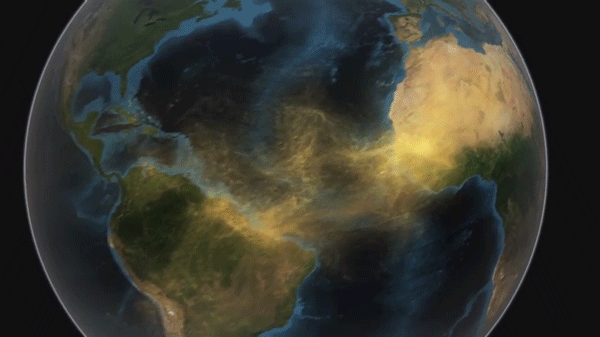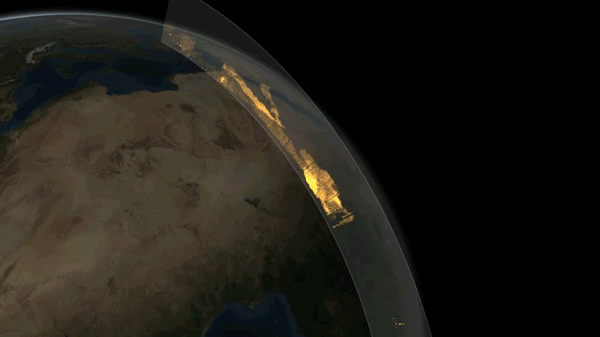News•February 25, 2015
How Sahara Dust Sustains the Amazon Rainforest, in 3-D

By Brian Kahn
The Amazon rainforest exists in part due to an atmospheric pipeline of dust from the Sahara Desert. And if that pipeline were to dry up or be diverted, massive biological changes could occur across the jungle.
The movement of dust from the Sahara to the Amazon.
Credit: NASA/YouTube

New research published on Tuesday in the journal Geophysical Research Letters uses satellite data to create the first three-dimensional look at how dust makes its way across the Atlantic. The findings provide researchers with another clue about how the fate of one of the wettest places on the planet is tied to that of one of the driest.
Winds whipping across the desert and surrounding semi-arid areas kick dust high into the atmosphere for the start of a 6,000-mile trip to the Amazon basin every year. The new research uses recent satellite data covering the period from 2007 to 2013 to show just how massive the dust plume is.
RELATEDNew Amazon Carbon Maps May Help Limit Deforestation
Drying Amazon Could Be Major Carbon Concern
Dust in the Wind Could Speed Greenland’s Ice Melt
The biggest pulses of dust come in winter and fall when an estimated 27.7 teragrams of dust make the Atlantic crossing. Teragrams not your thing? That’s 182 million tons or equivalent of 498 Empire State Buildings in the estimation of Hongbin Yu, lead author of the new study. Of that, nearly 28 million tons (or 75 Empire State Buildings, if you will) land in the Amazon.
“There have been studies linking dust with the Amazon basin, but how much dust is transported is unknown. It’s been unknown for awhile. You can use a model but models have large uncertainties,” Yu, an atmospheric scientist with NASA’s Goddard Space Flight Center in Maryland, said.
By observing multiple years, Yu’s results show the year-to-year variability in dust transport. In particular, they reveal that when the semi-arid region south of the Sahara, known as the Sahel, has an above normal rainy season during the summer, winter and spring dust transport tends to be lower.
Some research has shown that climate change could mean a wetter Sahel. That could have a downwind effect on the Amazon, which itself is projected to dry out as the world warms.
Kátia Fernandes, a research scientist at the International Research Institute for Climate and Society, said that this aspect of the study showed one of the main advantages of looking at multiple years in this context. She added that the study was “an important addition to the collection of satellite information available for climate and ecosystem studies.”
Why so much ado about dust in the wind? Because it contains phosphorus, a crucial nutrient that plants need to grow. Amazon soils run a phosphorus deficit as high as 90 percent, with rainfall and rivers washing it out to sea regularly.
Decomposing leaves and plants help recycle some of the phosphorus already in the Amazon, but dust provides a key outside source of the nutrient.
“In the long-term, if you don’t have this then it will keep losing phosphorus. Biodiversity could change or we could see other plant adaptation mechanisms,” Yu said.
Satellite data was used to create a 3-D view of dust transport.
Credit: NASA/YouTube

Dust and other small particles known as aerosols can also influence weather around the globe, including the Atlantic hurricane season and speed ice melt in Greenland.
The data to create the new 3D view of dust comes from NASA’s CALIPSO satellite. The satellite has lidar, a laser-based technology, aboard to provide a cross section view of clouds, dust and other particles that get stirred up in the atmosphere. Circling the globe provides the third dimension to give scientists a view of Sahara dust and its transport to the Amazon basin.
Yu’s results still have some uncertainty as well, but he said that better remote sensing technology would help cut it down.
Natalie Mahowald, an atmospheric scientist at Cornell University, said the study provides a stepping stone because it, “gives us much more confidence when we obtain similar results with different methods. It is very exciting that the satellites are able to provide such a 3-D view of the movement of aerosols.”
You May Also Like:
Europe Reforms Cap-And-Trade, Lays Out Climate Vision
Three Tools to Solve The Mystery of Ocean Acidity
For the West, A Winter That Has Felt More Like Spring
Obama’s Keystone XL Veto Not a Death Blow to Pipeline
